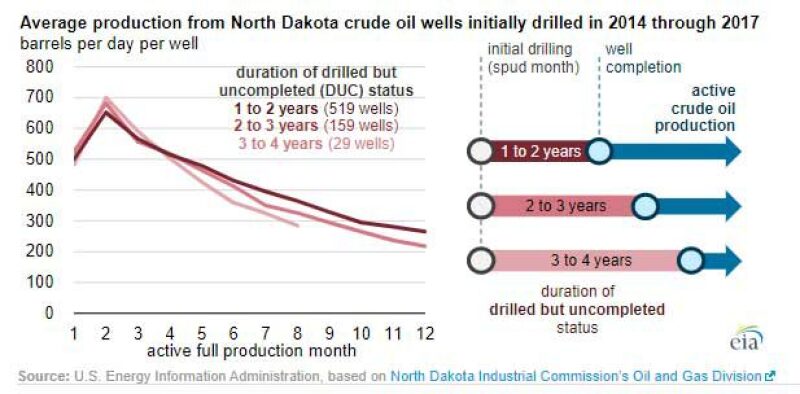Like what you're reading? Sign up for the new JPT Unconventional Insights newsletter to get the latest news to your inbox. |
Delaying a completion by as many as 4 years has “little effect” on the initial production level, according to a new study by US Energy Information Administration (EIA).
The study tested the assumption that long-delayed completions mean a well is not worth the cost.
“Some people say you cannot fracture a well drilled more than a year ago,” but the data says otherwise, said Jozef Lieskovsky, a senior analyst for the EIA who coauthored the report.
The study looked at Bakken wells dating back to 2014, when the oil price crash caused a surge in drilled but uncompleted wells (DUCs) as companies slashed spending. What the EIA found was that the average initial production for the oldest wells (3-4 years old) peaked at a slightly higher level that the youngest ones (1-2 years old).
Based on the sample sizes, there was a limited number of older wells completed between 2014 and 2017. While there are production records of 519 wells completed from 1-2 years after drilling, that dropped to 159 wells that were 2-3 years old, and only 29 from 3-4 years old.
Over time it appears the wells in the 1-2 year group slightly outperformed the older ones. Lieskovsky cautioned against drawing conclusions from small differences. He said the averages included some non-well-related factors, such as adjustments made to limit the impact of operational differences, such as choking back early production due to pipeline capacity constraints.
North Dakota wells were studied because the North Dakota Industrial Commission’s Oil and Gas Division offers one of the best databases covering completions and performance. Another plus was that the wellbores for Bakken wells were mostly about 10,000-ft long in 2014, as most are now, so the wells then and now were comparable. Comparisons are tougher in the Permian where wells were growing longer during that period.
Most of the completions were done in 2018 and 2019, so the fracturing technology used was of the same era, Lieskovsky said.
An unanswered question in his mind was how wells drilled and fractured in 2014 would compare with ones drilled back then and fractured years later. He said more sand, water, and densely-spaced fracturing clusters might make up for any damage done during that long wait.



